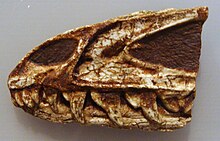Dracovenator
| Dracovenator | ||||||||||||
|---|---|---|---|---|---|---|---|---|---|---|---|---|

The type material in an exhibition at the Royal Ontario Museum . |
||||||||||||
| Temporal occurrence | ||||||||||||
| Lower Jurassic (? Hettangium ) | ||||||||||||
| 201.3 million years | ||||||||||||
| Locations | ||||||||||||
| Systematics | ||||||||||||
|
||||||||||||
| Scientific name | ||||||||||||
| Dracovenator | ||||||||||||
| Yates , 2005 | ||||||||||||
| Art | ||||||||||||
|
Dracovenator ("dragon hunter") is a genus of early theropod dinosaur from the lower Jurassic South Africa .
The holotype is a fragmentary skull made up of the intermaxillary bone ( premaxillary) and parts of the upper jaw (maxillary) and lower jaw (mandibular). Another snout fragment originally attributed to " Syntarsus" rhodesiensis could come from a young of the genus. The only known species is Dracovenator regenti .
features
Dracovenator is estimated to be 5.5 to 6.5 meters in length. It can be distinguished from other genera by a double-lobed depression (fossa) on the lateral surface of the intermaxillary bone, which is connected to the tooth sockets by a narrow pit.
Find and naming
The only specimen comes from the Elliot Formation , an important fossil deposit in South Africa. These rock strata can be dated from the Hettangian to Sinemurian , i.e. they fall into the Lower Jurassic . The name Dracovenator ( lat. Draco - "dragon"; venator - "hunter") refers to the Drakensberg ( Eng. "Dragon Mountains"), the highest mountain range in South Africa, in the vicinity of which the site is located. The second part of the species name, regenti , honors Regent Huma, who discovered the fossil together with James Kitching.
Systematics
Dracovenator is an original member of the Neotheropoda , which is generally located between the Coelophysoidea and the more advanced Averostra ( Ceratosauria + Tetanurae ). In the first description by Yates (2005) Dracovenator forms together with the Triassic Zupaysaurus the sister taxon to Dilophosaurus . In later work it is combined with Dilophosaurus and partly also with other genera to form the Dilophosauridae family .
Cladogram based on the first description by Yates (2005).
| Theropoda |
|
||||||||||||||||||||||||||||||
|
|
Cladogram according to Hendrickx et al. (2015).
| Neotheropoda |
|
||||||||||||||||||||||||||||||||||||
|
|
Individual evidence
- ↑ a b c d e f g Adam M. Yates: A new theropod dinosaur from the Early Jurassic of South Africa and its implications for the early evolution of theropods. In: Palaeontologia Africana. Vol. 41, December 2005, ISSN 0078-8554 , pp. 105-122.
- ^ A b Nathan D. Smith, Peter J. Makovicky, Diego Pol, William R. Hammer, Philip J. Currie: The dinosaurs of the Early Jurassic Hanson Formation of the Central Transantarctic Mountains: Phylogenetic review and synthesis. In: Alan Cooper, Carol Raymond, and the 10th ISAES Editorial Team (Eds.): Antarctica. A Keystone in a Changing World (= USGS Open-File Report 2007-1047 = Short Research Paper 003). Proceedings of the 10th International Symposium on Antarctic Earth Sciences, Santa Barbara, California, USA - August 26 to September 1, 2007. National Academies Press, Washington DC 2008, ISBN 978-0-309-11854-5 , doi : 10.3133 / of2007 -1047.srp003 , (PDF file; 3.01 MB).
- ^ A b Charlton T. Lewis, Charles Short: A Latin Dictionary founded on Andrews' edition of Freund's Latin Dictionary. Clarendon Press, Oxford 1879.
- ↑ a b Hendrickx, C., Hartman, SA, & Mateus, O .: An Overview of Non-Avian Theropod Discoveries and Classification. In: PalArch's Journal of Vertebrate Palaeontology. 12 (1), 2015, pp. 1–73.
